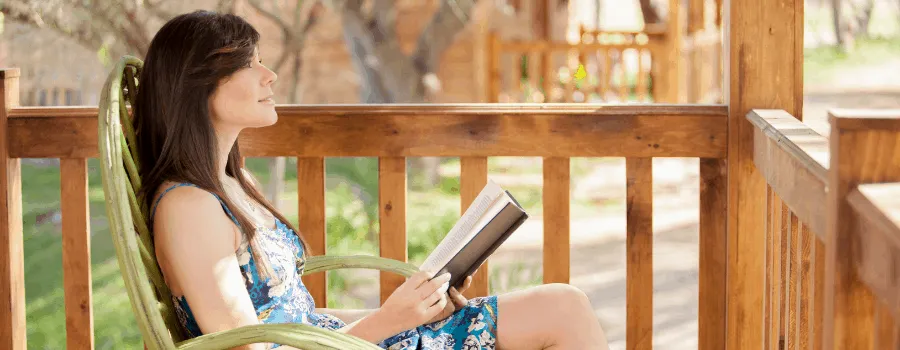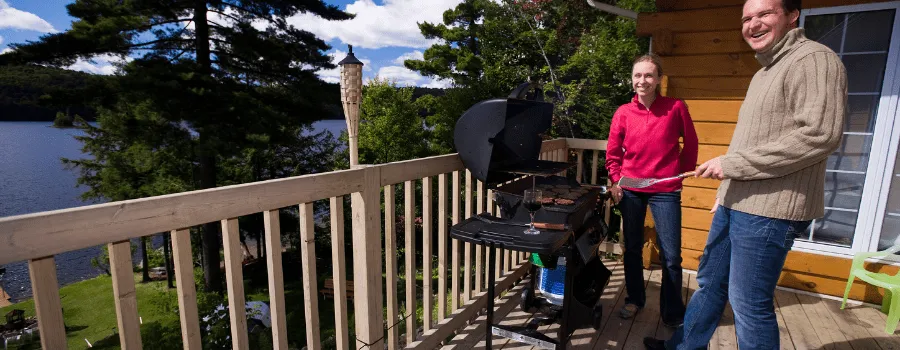To determine what is a good size for a backyard deck, there are many factors to consider. Or, to put it another way, what is the right size deck should you build in your back yard.
The sizing of a backyard deck is highly influenced by functionality. The intended use of the deck. The relationship of the deck to the house also impacts the size and layout of a deck.
A good size deck starts at 12 feet by 12 feet but can be as small as 8 feet by 8 feet for limited specialty use, such as a sitting area or a barbeque area just outside of the kitchen. Also deck should be no larger than the largest room in the house and not exceed 20% of the house square footage.
These are simple rules to start thinking about deck proportions. There are some cases where a smaller deck than 12’x12′ will work quite well, but a deck for gathering with friends and family should be no smaller in most cases.

Also, keep in mind that bigger is not necessarily better. Just because you can build a 600 sq’ deck doesn’t mean you should. Building a deck too small will limit use, so will building a deck too big.
Which brings us back to a primary question.
What do you want to use the deck for?
Helping you to answer, there are three primary uses for a deck.
- Lounging
- Dining
- Grilling
Of course, there are many combinations and varieties of these but answer which of these you desire will guide you in defining the deck’s size.
Good Deck Size for Lounging
If your primary desire is a place to sit and enjoy the outdoors, you will want to build your deck around your lounging chairs. Building a deck large enough to comfortably around the chairs with room to move. The last thing you want is to have to climb over someone else to get to your chair.
A simple place to sit and sip ice tea in the sun requires the least amount of space. A chair on your deck will take up about 9 sq’, or roughly 3’x3′ (0.9×0.9m). Add another foot for your feet, and you need a deck at least 4′ (1.2m) deep.
If you want to share this moment with some special, your deck needs to be a minimum of 9′ (2.7m) wide and 4′ (1.2m) deep. Ideally, with the door from the house in the middle of the deck. For you can go from the house to your chair without disturbing each other.

Enjoy rocking back and forth while out soaking up the sun? A rocking deck chair will need an additional 1′ (0.3m) of depth. Increasing the deck for two to 5’x9′ (1.5×2.7m).
Even though this is large enough for two, you are close to the railing. With a low railing of 36″ (915mm), you will be able to see over the top rail. Any taller, and you will wish the deck was deeper and the railing farther away. As to not feel so tighly enclosed.
A single chaise lounge chair will take up 3′ by 7′ (0.9×2.1m) of a deck. Plus, you will want the same amount as a walkway. Meaning a lounging deck can be no less than 9′ by 7′ (2.7×2.1m) to enjoy being outside with a friend. But you would be much better with a slightly larger deck, 10′ or 12′ wide and 8′ (3-3.6×2.4m) deep attached to your house. Giving you some options in the arrangement of the loungers and room to move. The extra space also allows you to have a small table to hold your drink or rest your book on.
“Calming factor of being outdoors”
Paul Lafrance
If you are planning a more formal lounging arrangement similar to your living room in your house but outdoors. You will need a bigger deck but your living room will give you an idea of deck size. Even better measure and arrange the deck furniture
If you have two Wicker Outdoor Patio Sofa providing seating for 4-6 people set up in a L shape. Both sofas will fit on a 10’x10′ (3x3m) deck. But a better size deck would be 12’x12′ (3.6×3.6m). Giving enough room to set up the sofas with a small table and room to move. Always build enough deck for room to move.
Sofa providing seating for 4-6 people set up in a L shape. Both sofas will fit on a 10’x10′ (3x3m) deck. But a better size deck would be 12’x12′ (3.6×3.6m). Giving enough room to set up the sofas with a small table and room to move. Always build enough deck for room to move.
As you see, the type, quantity and arrangement of deck furniture impact the size of the deck needed. Often the best solution is to start with the furniture and then build the deck accordingly. If you already have the furniture, you intend to use on your deck. Set them up in the yard, arranging them most comfortably and conveniently possible. Then measure how much room they use. Then build the deck accordingly.
accordingly. If you already have the furniture, you intend to use on your deck. Set them up in the yard, arranging them most comfortably and conveniently possible. Then measure how much room they use. Then build the deck accordingly.
Good Size Deck for Dining
Looking to do more on your deck? Dining on a deck is an excellent way to share food, fun and friendship. Yes, you can all lean against the rail, balance your plate on the steps and just make dining on your deck work. But even better is a table, with a few chairs and maybe even a deck umbrella for shade. Giving you outdoor comfort, while enjoying your latest creation.
To see some possibilities for deck dining sets , click the link.
, click the link.
Just like lounging on your deck, there are a few different ways to do this. It is not unusual to have a few outdoor sofas with a low table between them to enjoy a bite outside. Which if probably arrange, can work very well.

But for designing a deck for dining, we will assume a table and chairs for everyone. When you have the extended family over for the May long weekend barbeque, this will look different, but for now, design for the ideal deck size for family dining.
First, how many people are you planning for? Ninety percent of the time, how many friends and family do you hope to have out on the deck? Again, not Fourth of July Celebrations but all the other days, weekends of the year.
If dining is going to largely your family of four, then plan for an appropriate table and deck size. Often in this situation, you will want a place for your table plus an “overflow” area for when friends come over, but we will get to that later.
Most deck tables for four will take up 16 sq’ of deck, plus chairs and a little room to move, which goes like this.
| Deck Furniture | Deck Used |
| Deck Table for 4, 4′ | 4′ |
| Deck Chairs, 2′ on each side of the table | 4′ |
| Room to move, Add 1′ behind each chair | 2′ |
| Total Require Deck Size | 10′ |
A table for 4 is great in that it’s often square or round. So, the depth of your deck is equal to its width. The deck needs to be 10′ wide and 10′ deep (3x3m) in this example.
Practically speaking, unless you go with a small breakfast table. If it’s just the two of you dining on the deck, a 10′ (3m) square deck is a good size. It can be a little smaller with a breakfast table or the table off to the side against the railing. But a bigger square deck will work better. Accommodating you regularly and the occasional times when a few friends join you.
But that’s the bare minimum. Just enough deck to fit a table, four chairs and enough room to sit down. If your deck has stairs down to the yard. A path free of furniture would be nice. You can then run down to the barbeque on the patio without bumping into anyone or dripping blood from the steak plate on the table. A walking path just like the hallways in your house should be 3′ (0.9m) wide. It can be a little smaller, but three feet is better.
without bumping into anyone or dripping blood from the steak plate on the table. A walking path just like the hallways in your house should be 3′ (0.9m) wide. It can be a little smaller, but three feet is better.
Jumping our deck size for four to 13′ (3.9m) wide and 10′ (3m) deep. Big enough to fit the table, chairs, a path to the yard and let’s not forget four people. A little tight on the edges but still big enough to enjoy.
If we consider deck construction, like joist spans, footing requirement and standard material lengths. I will explain all this in more detail later. The ideal dining deck for a family of four is 16′ wide and 12′ deep (4.8×3.6m). A very versatile and practical deck size.
Versatile in that you can fit a larger table on the same size deck. Or have the table to one side and a few chairs on the other. Allowing you to combine lounging and dining on the deck . Or a picnic table and barbeque all on the same deck. The options are practically limitless.
. Or a picnic table and barbeque all on the same deck. The options are practically limitless.
Practically, with a rectangle table, you can sit up to 10 people on a 16′ (4.8m) wide deck. Table that is 8′ (2.4m) long and half the width, fitting nicely on a 16′ wide and 12′ deep (4.8×3.6m).
Groups smaller than ten can fit on a smaller deck but stick with the larger size for practically deck construction unless other reasons are limiting the deck size. A little extra room to the size will not be regretted, but not enough room will.
A larger family or a few more friends dining out on the deck will change its dimensions a little. With rare exceptions, you will be better designing a multiple-level deck with spaces and tables for multiple groups to gather for gatherings larger than ten. Unless you really want the banquet table for a king feel. Groups, decks and tables work better for ten or less.
A Good Size Deck for Grilling
A dedicated deck for the barbeque. Taking the heat, smoke and smell outdoors while enjoying grilled food inside. In Calgary, this is very common. People love barbequing, but because of our long winters prefer dining in a while cooking out. A deck just outside the kitchen lets you do both.
The size of the grill and fuel type will significantly impact the size of the deck.
The safest and requiring the least space are gas barbeques. Either portable propane or plumbed in natural gas. The biggest reason is fire control and spark. Gas fires have limited sparks requiring less clearance from the house, trees, railing and the deck itself. In short, gas allows for a smaller deck size.
Next to fuel is the grill size. Simple arithmetic, a grill 6′ wide will need a bigger deck than 2′ portable barbeque. Often best is to start with the grill you want and build the deck accordingly. Always account for clearance, as not to burn your house down, and consider smoke.

But for the sake of our conversation, let’s assume a three-foot-wide (1m) gas barbeque, only requiring 6″ (150mm) clearance. Giving us a good idea of deck size, but we can adjust if you upgrade.
The bare minimum grilling deck size is 5’x4′ (1.5×1.2m). Just enough room to step out the door, stand in front of the barbeque and flip the burgers. But a deck this small will require aluminum railing as not to damage the railing from the heat and flames from the barbeque. This includes no room for a chair. Just the barbeque and a place to stand.
and flames from the barbeque. This includes no room for a chair. Just the barbeque and a place to stand.
One of the drawbacks of such a small deck, is smoke will still get into your house. Even with the door closed, and we both know it won’t always happen. Smoke can drift into a second-story window. It just is really too close for comfort.
You also run the risk of melting the vinyl siding. Six inches (150mm) is not a lot of area to prevent a sudden burst of flames. It may not be from the fire itself but when you flip that overly greasy patty, a burst of flames can melt the siding. Stucco on the house will minimize some of this risk, but it can become stained.
For a fuller discussion about placing a grill on a deck,  click the link.
click the link.
A better size grilling deck size is a 12’x12′ (3.6×3.6m), or even better, a barbeque bump out, minimizing the risk of touching the grill while distancing the barbeque further away from guests and the house. This deck size also creates space for a table and a few chairs. For you can both enjoy cooking and eating outdoors.
Which leads us to next determining factor in backyard deck size.
Best Deck Size for Multiple Activities.
Very few of us only do one thing on our deck. Most of us, just like in our houses, use our decks for a combination of things. Taking a few minutes to relax after work, sitting on the deck watching the birds scooter about. But come the weekend, we have a few friends over, put up the umbrella and share a few drinks and laughs. But don’t be surprised if some burgers come out. Friends and food are such an excellent combination. Your deck needs to be designed accordingly.
Big enough to fit, small enough to enjoy.
As we have seen repeatedly, a 12’x12′ (3.6×3.6m) deck is almost the smallest you want and most versatile. If you are combining activities, a little bigger is better. A 16′ wide by 12′ deep (4.8×3.6m) deck allows you to double up. Long enough to set up the barbeque plus room for a table to eat by. Or if grilling is not your thing, a table on one end and couches or lounger on the other side. Letting you adjust sitting positions or two groups of people together on the same deck. Kids playing games on the table, adults sipping drinks on the couches. Or if you want to stretch out in the sun, the lounger is ready and doesn’t have to be set up.
Good Size Backyard Deck for Entertaining
This includes all three above plus whatever combination you can put together. But if you are building a deck to be enjoyed by friends and family. A deck that is more than your personal retreat to relax in, from a world gone crazy. But a place for community, for neighbours, friends and long-lost but newly discovered relatives and anyone else you wish to entertain. To bring together, to enjoy your deck and company.

To start, how many people do you want to entertain on your deck regularly? Not how many people do you know, or that one time you posted on Facebook and the whole neighbourhood showed up. How many people do you generally have over 90% of the time?
I love entertaining big groups, but 11 to 14 people come out with some kids in tow most of the time. Generally, the kids play in the yard overrun off to the park. So, I only count the adults for my planning, those who will spend a majority of time on the deck. This might be different for you.
“20 square feet of deck per Guest.”
For entertaining, I will need a 280 square foot deck. Roughly 24′ wide by 12′ deep (7.2×3.6m). Dimensions do matter, and I will talk more about that. Big enough to fit everyone but not so huge that people get lost on it.
If you plan to have a large table or outdoor couches, additional room on the deck will be helpful. As they will take up some of the deck space.
There are many different ways of arranging decks for entertaining. Instead of a long rectangle deck, the same size deck but 18′ x 16′ giving guests more room. By creating a larger central area. Which can be great for entertain a single group.
“it is Quality of square footage over quantity.”
Paul Lafrance
But often, you are better with distinct areas. The deck naturally bringing people together while allowing for more individual conversations. Instead of one extended deck, a 12′ x12′ (3.6×3.6m) deck level with the patio door with a lower 12 x12′ (3.6×3.6m) seating area a few steps down, which makes conversation easier on the lower deck by reducing background noise. Along with providing extra seating on the steps between the two decks. Along with multiple gatherings at the same time.

What you do on the deck is the most crucial part of determining the right deck size for your home. But since I build decks. That’s where I spend most of my time and where my passion lies. I would not feel complete without discussing deck construction concerning deck size. But if you don’t plan to construct the deck yourself, this may not be for you, and you can skip ahead to the conclusion. But if you want to learn more, the “thoughts of a carpenter.” Here is what I think about when determining the right deck size.
Good Size Deck for Construction
Now for the practical conversation about building your deck. Most decks don’t come as a kit out of a box. But still, there are some guiding principles to get the right size deck at the best price. You are free to design and build your deck whatever size you wish. By letting the material and building code guide you, you will create the best deck at the best price.
Build the Deck to Even Numbers
Lumber for joists and decking material are all sold in even lengths. You may only need a 9′ by 5′ (2.7×1.5m), but it often makes more sense in construction to round up to 10′ by 6′ (3×1.8m). Deck sizes less than even numbers mean you are paying for the material but not using it. Yes, there are aesthetic reasons to not the full length of the material. But the closer you are, the less you are paying per sq’ of the deck.
mean you are paying for the material but not using it. Yes, there are aesthetic reasons to not the full length of the material. But the closer you are, the less you are paying per sq’ of the deck.
Build to Maximum Joists and Beam Spans
It is a good practice building to even numbers when building a deck and the material’s full potential. For example, joists have limits of how long they can span between the ledger and the beam. Support to Support. Before building, check with your local building codes, but a quick rule of thumb is joists can span one and a half times the nominal length.
2×8 joist can span= 8×1.5=12’
Meaning with a 2×8 joist, you can build a deck 12′ (3.6m) deep before you need any additional beams. The best use of material and labour is to build the deck to its full depth potential. Giving you more space on your deck for a minimal extra charge. The cost of a few additional deck boards gives you room to move around on your deck.
The same its true for 2×10 and 2×12 joists, one and half the joist material’s height.
As an aside but very relevant when deciding the deck’s size, building code requires a minimum of 2×8 joists for a deck with guard rails. Meaning if your deck is raised enough to need railing, building it 12′ (3.6m) deep just makes sense.
Sizing Your Deck by Footing Placement
In some jurisdictions, there are complicated calculations for sizing and placing of footings. Always check when designing your deck for your local building code. But the Canadian Wood Council beam chart makes it easy. Spacing your deck posts, footings either 4′, 6′ or 8′ spacing (1.2, 1.8 and 2.4m). The beam’s size is adjusted in relation to the joists’ spans but more to my point.
At the cost an additional beam ply you can reduce footings up to eight feet (2.4m). It just makes sense to go the biggest span you can build to. This comes into play when comparing between building a 12′ (3.6m) wide deck or 16′ (4.8m). Both the twelve (3.6m) and sixteen-foot (4.8m) deck need three footings supporting the deck. So why not build the larger deck? Giving you additional deck space.
Limitations of Deck Size
Now for the other side of the coin.
Decks Sized for Aesthetic Beauty
First, as Paul Lafrance said about quality over quantity, bigger is not always better. With a deck that is often as much a work of art as a place to relax. Art demands proportions, limitations in scope to be welcoming in space. If your deck is too large to be welcoming, it will not be enjoyed. Build a deck that will call to you from inside the house. Anything less, is a wasted deck.
There are also some practical considerations for deck size.
Deck Size Complimenting Your House
Being outdoors is amazing. Breathing in the fresh air, enjoying the open sky. What is not to like about spending time outside on your deck?
But a deck should not dwarf your house. The deck is part of your home, not your home. As a general rule, your deck should not exceed 20% of the house. A 2 000 sq’ house should not have a deck larger than 400 sq’. Yes, there are some exceptions but always keep proportions in mind. This is the total square feet of the house, both the main and second floor. With bungalows, you might be able to exceed this number a little more than a two-story house. The bungalow having a larger footprint than a two-story house of the same size.
On top of overall size is complimenting rooms inside of the house. Generally, a deck should be no larger than the largest room in the house. Which often is the living room. What is the point of a larger gathering place outside of your house than inside?
The great news is that you already know what size you want your deck. If you are building a deck for lounging in with a few outdoor couches. Measure your living room, maybe add a few feet for walking to the yard and your set. Big enough to set up your outdoor furniture and room but small enough to be comfortable.
A Good Deck Size Conclusion
The right deck size is as individual as the people enjoying it. Regardless of guiding principles, you want to build a deck that will be appreciated. If this means bigger or smaller than most, to create a welcoming, functional deck that you will enjoy.
Just like in your house, every room has a primary function. The right deck size is also determined by use. Build a deck to suit its intended use. Whether this is Lounging, Dining, Grilling a combination or something else entirely. Spend some time dreaming of how you will enjoy your deck and how much space you need to enjoy that activity.
There are construction considerations for deck size, but still, a deck should be an inviting size. Proportional to your house, complementing your lifestyle and budget.
Above all, build a deck the size that you will enjoy!
